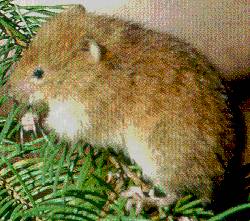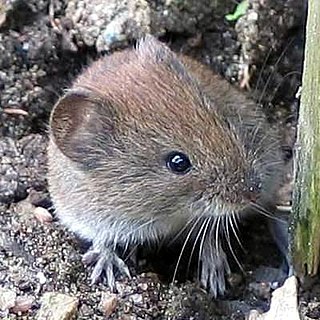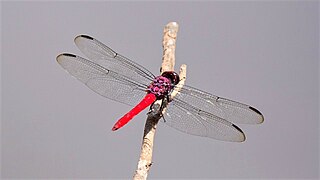
Voles are small rodents that are relatives of lemmings and hamsters, but with a stouter body; a longer, hairy tail; a slightly rounder head; smaller eyes and ears; and differently formed molars. They are sometimes known as meadow mice or field mice in North America.

The Arvicolinae are a subfamily of rodents that includes the voles, lemmings, and muskrats. They are most closely related to the other subfamilies in the Cricetidae. Some authorities place the subfamily Arvicolinae in the family Muridae along with all other members of the superfamily Muroidea. Some refer to the subfamily as the Microtinae or rank the taxon as a full family, the Arvicolidae.

The genus Arborimus is a group of voles found in western North America. The genus name is Latin for "tree mouse". Some sources include this genus with the heather voles, genus Phenacomys, and both are classified in the tribe Phenacomyini.

The bank vole is a small vole with red-brown fur and some grey patches, with a tail about half as long as its body. A rodent, it lives in woodland areas and is around 100 millimetres (3.9 in) in length. The bank vole is found in much of Europe and in northwestern Asia. It is native to Great Britain but not to Ireland, where it has been accidentally introduced, and has now colonised much of the south and southwest.

The collared peccary is a species of artiodactyl (even-toed) mammal in the family Tayassuidae found in North, Central, and South America. It is the only member of the genus Dicotyles. They are commonly referred to as javelina, saíno, or báquiro, although these terms are also used to describe other species in the family. The species is also known as the musk hog. In Trinidad, it is colloquially known as quenk.

The genus Lemmus contains several species of lemming sometimes referred to as the true lemmings. They are distributed throughout the Holarctic, particularly in the Palearctic.
The royal vole, also called the Korean red-backed vole, is a species of vole endemic to the Korean Peninsula. It lives underground in a burrow, emerging at night to feed on grasses, seeds and other vegetation. The International Union for Conservation of Nature has listed its conservation status as being of "least concern".

The grey red-backed vole or the grey-sided vole is a species of vole. An adult grey red-backed vole weighs 20-50 grams. This species ranges across northern Eurasia, including northern China, the northern Korean Peninsula, and the islands of Sakhalin and Hokkaidō. It is larger and longer-legged than the northern red-backed vole, which covers a similar range and it is also sympatric with the Norwegian lemming.
The Hokkaido red-backed vole is a species of rodent in the family Cricetidae. It is found at high altitudes on the island of Hokkaido in Japan and at lower altitudes on some smaller islands nearby. Its natural habitat is temperate forests.
The Clethrionomyini are a tribe of forest voles in the subfamily Arvicolinae. This tribe was formerly known as Myodini, but when genus Myodes was deemed to be a junior synonym, the tribe was renamed. Species in this tribe are:

The common agama, red-headed rock agama or rainbow agama is a species of lizard from the family Agamidae found in most of sub-Saharan Africa. To clear up centuries of historical confusion based on Linnaeus and other authors, Wagner et al. designated a neotype for the species, using a previously described specimen from Cameroon in the collection of the Zoologisches Forschungsmuseum Alexander Koenig in Bonn. The species name was formerly applied to a paraphyletic collection of taxa ; subsequent mitochondrial DNA analysis of various populations indicates they represent separate species. Consequently, three former subspecies A. a. africana, A. a. boensis, and A. a. mucosoensis are now considered separate species, and A. a. savattieri is considered synonymous with A. africana.
Craseomys is a genus of small, slender voles.

Orthemis schmidti, also known by its common name red-tailed skimmer is a species from the genus Orthemis. The species was originally described in 1950 by Karl Friedrich Buchholz.









